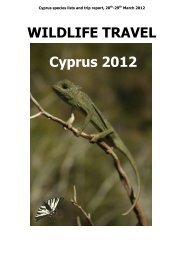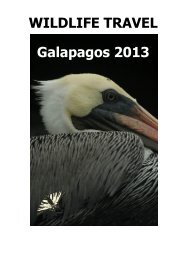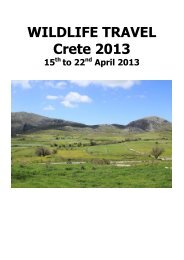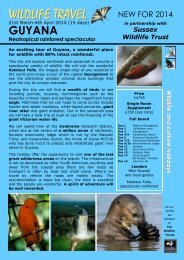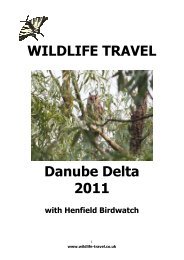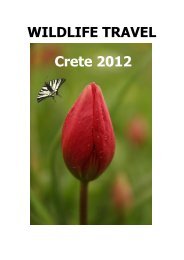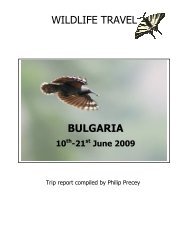WILDLIFE TRAVEL TASMANIA
Tasmania 2013 - Wildlife Travel
Tasmania 2013 - Wildlife Travel
You also want an ePaper? Increase the reach of your titles
YUMPU automatically turns print PDFs into web optimized ePapers that Google loves.
5 th January 2013. Mount Wellington<br />
Tasmania 2013: trip report and species lists<br />
Overnight the temperature dropped and the winds changed direction, so at least the city didn’t feel quite so much like<br />
a furnace, and yesterday’s smoke had cleared. But with Mount Field National Park still closed due to the fire risk, we<br />
instead headed south west and up to Mount Wellington, where followed in the footsteps of Charles Darwin who made<br />
the trek to the summit in 1836.<br />
A small group of Tasmanian Native Hens were by the roadside at the bottom of the mountain, while stopping on the<br />
way up, we found a pair of Flame Robins, the female a brown flycatcher-like bird but the male glowing bright orange,<br />
and a Crescent Honeyeater flew in to a nearby tree.<br />
From the summit we enjoyed the spectacular views down over Hobart, with the fires beyond Mount Field to the west<br />
and at two spots along the Tasman Peninsula to the east all too visible. Cicadas bumbled around the vegetation<br />
together with amorous flightless mountain grasshoppers, but the only birds were four Forest Ravens around the<br />
summit and a soaring Brown Falcon overhead. Plants included the dainty Wahlenbergia saxicola, Tasmanian Eyebright<br />
Euphrasia collina ssp diemenica, the suitably-named Rock Daisy Bush Olearia ledifolia and the cream spikes of<br />
Mountain Rocket Bellendena montana. As we travelled down through the forest, we found a single Tasmanian<br />
Waratah Telopea trunctata in flower, with its bright red flowers, as well as the showy white flowers of Christmas<br />
Mintbush Prostranthera laianthos and the purple fruits of Purple Cheeseberry Cyathodes glauca.<br />
Our lunch stop was in the shade at Three Springs, from where we took a short walk out to a view point, through the<br />
woodland. The first orchids of the trip came in the form of the glamorously-named Potato Orchid Gastrodia<br />
sesamoides and a lovely green hood orchid Pterostylis grandiflora. At the lookout, large numbers of Macleay’s<br />
Swallowtail butterflies were patrolling their territories. A very noisy and (eventually) showy pair of Grey Shrikethrushes<br />
spent quite a bit of time around the path, although shyer were the Superb Fairy-wren, Brown Thornbill and<br />
Grey Fantail, all of which flitted through very quickly. On the way back we got good views of a Yellow-throated<br />
Honeyeater, and at the car park a handsome Black Currawong and a brief fly-through Green Rosella brought our list<br />
of endemics for the day to four.<br />
6 th January 2013. Hobart to Bruny Island.<br />
With Mount Field still closed due to the fires, we chose to have a quick morning walk around the reservoirs at<br />
Waterworks Reserve, on the edge of Hobart. Here we got our first close-up look at Tasmanian Native Hen, with a<br />
family feeding on the dam. Out on the water, a small group of Pacific Black Duck also included a pair of Hardhead,<br />
with a handful of Hoary-headed Grebe dotted amongst the larger numbers of Coot. An Echidna briefly popped his<br />
nose out of his burrow, but scuttled back before the group could get a look. Back at the bus, much less shy were the<br />
Sulphur-crested Cockatoos flying noisily overhead.<br />
Making our way to the ferry to Bruny Island, the oil light on the bus started flashing, alerting Mark to the fact that the<br />
previous driver of the bus had misplaced the oil cap! With the problem eventually fixed, we took our place in the<br />
queue for the ferry across to Bruny, at the familiar-sounding but very unfamiliar looking Kettering, where a Blackfaced<br />
Cormorant fished in the bay.<br />
Once we got onto Bruny, we headed slowly south, passing sandy beaches and shallow bays home to Black Swans and<br />
both species of Oystercatcer (Australian Pied and Sooty), before arriving at Cape Bruny, part of South Bruny National<br />
park. Here, among the burned understory were abundant red spikes of Tasmanian Christmas Bells Blandfordia<br />
punicea in full flower, and we also managed to track down a flowering Banksia marginata; the small Purple Flag<br />
Patersonia occidentalis and taller White Flag Diplarrena moraea; and the bizarrely beautiful Duck-billed Orchid<br />
Cryptostylis subulata.<br />
A Wedge-tailed Eagle came low overhead while several brown butterflies flittering around in the sunny woodland<br />
were the bizarrely-named Klug’s Xenica.<br />
After settling into our various accommodations we reconvened at Inala, a ‘Land for Wildlife’ property where we met<br />
Tonia, our local guide for the next 24 hours, and enjoyed a delicious meal of barbequed salmon before once again<br />
boarding the bus for our first night drive… From Inala we headed back up the island, across the ‘Neck’ and into North<br />
Bruny. As it got dark, we came round a bend to find our first Eastern Quoll running across the road: the size of a<br />
large kitten, gingery with white spots and a pointy face. And then another. And then another… by the end of the<br />
evening, we’d come across at least 35 of these characterful little predators, in ones, twos and threes, both the<br />
commoner ginger colour morph and the rarer dark brown morph.



